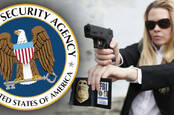After blowing $100m to snoop on Americans’ phone call logs for four years, what did the NSA get? Just one lead
The controversial surveillance program that gave the NSA access to the phone call records of millions of Americans has cost US taxpayers $100m – and resulted in just one useful lead over four years.
That’s the upshot of a report [PDF] from the US government’s freshly revived Privacy and Civil Liberties Oversight Board (PCLOB). The panel dug into the super-snoops’ so-called Section 215 program, which is due to be renewed next month.
Those findings reflect concerns expressed by lawmakers back in November when at a Congressional hearing, the NSA was unable to give a single example of how the spy program had been useful in the fight against terrorism. At the time, Senator Dianne Feinstein (D-CA) stated bluntly: “If you can’t give us any indication of specific value, there is no reason for us to reauthorize it.”
That value appears to have been, in total, 15 intelligence reports at an overall cost of $100m between 2015 and 2019. Of the 15 reports that mentioned what the PCLOB now calls the “call detail records (CDR) program,” just two of them provided “unique information.” In other words, for the other 13 reports, use of the program reinforced what Uncle Sam’s g-men already knew. In 2018 alone, the government collected more than 434 million records covering 19 million different phone numbers.
What of those two reports? According to the PCLOB overview: “Based on one report, FBI vetted an individual, but, after vetting, determined that no further action was warranted. The second report provided unique information about a telephone number, previously known to US authorities, which led to the opening of a foreign intelligence investigation.”
A short explanation of that sole useful investigation is redacted, so it is unknown what it covered or whether it proved useful or led to a prosecution.
Stalling
So, overall, millions of Americans’ phone logs were given to the NSA at a cost of $100m, and the result was the opening of one lone probe. It is perhaps no wonder that the NSA and the FBI has spent years stalling and refusing to hand over any information about the program.

FYI: FBI raiding NSA’s global wiretap database to probe US peeps is probably illegal, unconstitutional, court says
It’s also worth noting that the NSA has not once but twice shuttered the program because it ended up with millions of records it did not have a right to see – ie: the program was twice found to have gone out of bounds and used illegally. And yet the intelligence services still want to keep the program even if the legislation supporting it, the USA Freedom Act of 2015, expires on March 15.
The Trump Administration has asked that Congress extend the law so the NSA can, if it wishes, turn the program back on at some future date.
The lengthy report is a welcome return for the PCLOB, which was turned into a zombie organization unable to do any work for several years after its previous report on NSA spying programs concluded that they were illegal and Congress was obliged to scale them back.
Snowden
Those reports themselves stemmed from the fact that the full depth of the programs was exposed by NSA IT-admin-turned-whistleblower Edward Snowden in a vast leak of information.
And yet, despite it being made clear that neither Congress nor the PCLOB were able to adequately track or oversee what was really happening with America’s spying program, little or nothing has changed and repeat efforts by some in Congress to reform those programs have been repeatedly stymied.
Not to be beaten, several senators are again trying to scale back the various NSA surveillance programs, announcing a new bill last month aimed at ending NSA blanket snooping, protecting abuse of the FISA oversight process, closing various loopholes in the secret law that the spying agency uses, and expanding scrutiny of the programs.
The PCLOB notes in its report it was only able to gain access to the information it has now shared because the intelligence services agreed to declassify at least some of the details. And the only reason the snoops did that is because they concluded the program serves no real useful purpose anymore, thanks to the widespread use of encrypted messaging apps over telephone calls. Such apps are more secure.
As to what is happening with the NSA’s other spy programs, neither the PCLOB, nor Congress, nor even the highly classified secret FISA oversight court knows. And the only way it seems likely we will find out is if there is another Edward Snowden. ®
Sponsored: Detecting cyber attacks as a small to medium business
READ MORE HERE
